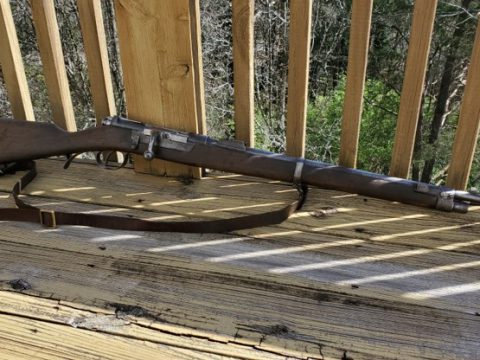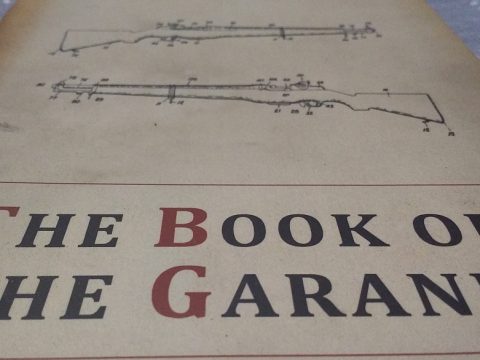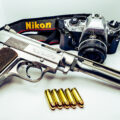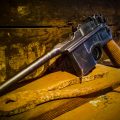In 1877 Li Hongzhang was planning to purchase some new rifles for his troops. Tianjin Arsenal, at Li’s behest, in charge of testing and buying new weapons. A Chinese official named Li Fengbao received letters from Tianjin Arsenal to let him investigate a suitable rifle for Chinese troops.
Late of this year, Li Fengbao received a sample rifle from Westley Richards in Birmingham then he sent the sample back to China for testing. Tianjin Arsenal described the rifle as Martini liked. We could not find more details about the sample rifle but it must be a Peabody falling block rifle which Westley Richards had been made for a long time.
In June 1878, Li fengbao sent Tianjin Arsenal one of each Hentry Martini, Peabody and Westley Richards which arrived in China two month later. The arsenal conducted comparison tests of three rifles and believed that the action of Westley Richards is strong and simple without coiled spring which can be easily rusted. However, Chinese concerned about the financial situation and production capability of Westley Richards. Li’s letters from London said the sale of the rifle was poor. Embassy also reported that the company stock worthies only 5 pounds and most of the machinery are pledge to the bank as collateral. Tianjin Arsenal wished Li could discover more rifles before reaching a decision.
In August 1878, Li Fengbao was appointed the commissioner of China to Germany. He moved from London to Berlin the same month. In Berlin, he visited Ludwig Loewe Company twice this year. The first visit happened right after his settlement in Berlin in mid August. Ludwig Loewe shown him a rifle which Li called “Rifle made by Loewe”. In early December, Li visited Ludwig Company for the second time and checked the rifle again. A German broker called Diapers&Co told Tianjin Arsenal that they had one sample of this rifle. In March 1879, an employee of Diapers&Co brought the sample to Tianjin.
The arsenal test report claimed: “Rifle made by Loewe” fires Mauser 11m/m cartridge. The cartridge gun powder weights 4.48 grams lighter than Martini Hnery MkII (5.5 grams) used by Westley Richards. “Rifle made by Loewe” penetrates into 7 inch wood while Westley Richards penetrates into 11 inches. “Rifle made by Loewe” has an advantage of simpler structure, which disassembles into 4 parts, than Westley Richards’ which disassembles into 12 parts”.
Tianjin Arsenal inquired at Ludwig Loewe Company about building 10 “Rifle made by Loewe” samples which should adapt to use barrels of Westley Richards, same caliber, length and rifling.
Ludwig Loewe had finished two samples before August. On 12 August, Li fengbao and attaché H.Octavius Brown were invited by Ludwig Loewe to observe the test. Three rifles were tested in this day. One Loewe sample with spike bayonet, one Loewe sample with sword bayonet and one Westley Richards for control. Both Loewe samples used Polygonal rifling and fired .450 MKII cartridge.
The test result as followed:

Chinese inspected rifles after the test found the action of Westley Richards was a little bit loose and recoil force kick harder than Loewe rifle. Chinese also said Polygonal rifling is outdated and difficult to clean. Chinese wrote specific requirements for the rest 8 samples:
- The rifles are chambered in British .500-450 MK2 No. 2 Musket cartridge
- 4 barrels made from British steel and 4 made from German steel
- 4 Polygonal rifling barrels and 4 conventional rifling barrels
- 4 rifles with spike bayonet and 4 with sword bayonet
- The position of bolt handle should have a proper location, turning of the bolt should be limited
- A stronger octagon shaped rifle chamber
- All samples should be well furnished and calibered
Ludwig Loewe built the rest samples in November, and the second test was conducted on November 22 and 23.
Chinese inspector Xu Jianyin and Luo Jichen participated the test. The weather was snowing so the test moved to a indoor range. Chinese inspector said because of the space limitation the rifles were only tested its strength of bolt action and its accuracy. The round target was placed 188 meters away.
Sample No.6 was tested on November 22, and sample No.2 was tested next day. Each rifle fired 100 rounds. Test of sample No.2 interrupted twice because the barrel was too hot to hold. The average accuracy of Sample No.2 is 12.35 and of no.6 is 12.67.
Chinese inspectors said the action was still solid and no powder fouling after tests. But three main problems had to be solved. First, the rifle used thread locking system which can be easily fouled by dirt. Second, the turning bolt required a lot of strength to close. Third, if you want to stop closing the bolt on its half way, you must hold the bolt by both hands and release it slowly otherwise the cartridge was very likely to be detonated accidentally .
After this test, Chinese did not leave further record of this rifle and few month later they purchased Mauser 71 and Martini Henry instead. Ludwig Loewe company provided a price list to Chinese in which the unit price ranges from 54 marks to 72 marks in terms of different quantity, that is way much higher than Mauser 71. Though Ludwig Loewe did not make a success on the rifle, but they did sell 200 S&W No.3 revolvers to China right after the second test.
I checked a 1930s book about Ludwig Loewe Company which mentions nothing about China. Before my discovery of these Chinese letters and telegrams, no one have talked about this history. The information about the rifle is so scant that we are unable to identify its model.

Enthusiast of the History of Chinese Mauser rifle
Check my research:https://mausercn.blogspot.com/
Feel free to contact me: zou.jiahong@yahoo.com/zou.aaron@outlook.com




